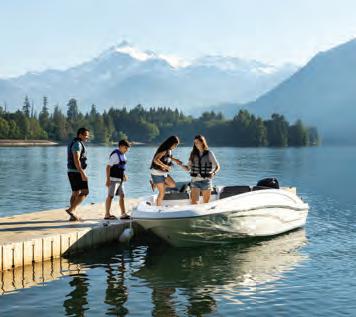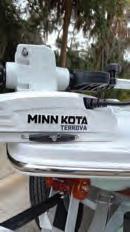































































Embarking on the open water is an exhilarating experience, flled with the promise of adventure and relaxation. Whether you’re a seasoned sailor or a weekend cruiser, protecting your vessel with proper insurance is not just a choice—it’s a necessity. Explore the reasons why every boat owner should prioritize boat insurance for a worry-free voyage.


The open water can be unpredictable, with unexpected storms, collisions, or other potential accidents. Boat insurance can give you fnancial protection if there is damage to your vessel, providing coverage for repairs or replacement.
Accidents on the water can result in damage to other boats, docks, or even injuries to passengers. Boat insurance offers liability coverage, which can pay for damages or injuries you’re liable for while boating, up to specifed limits, and lawsuit costs if you’re sued. This includes damage you cause to another watercraft or if someone on or near your boat is injured and you’re found to be legally responsible.
Unfortunately, boat theft and vandalism are realities that boat owners face. Boat insurance has comprehensive and collision coverage that can protect you against events outside of your control, including theft and vandalism.
Accidents on the water may lead to injuries for you or your passengers. Boat insurance offers a range of optional medical payments coverage limits, helping to cover medical expenses if you are in an accident or someone is hurt on your boat, regardless of fault.
If you fnanced the purchase of your boat, most lenders require insurance coverage to protect their investment. Having boat insurance not only fulflls these requirements but also gives you peace of mind knowing that your fnancial interests are safeguarded.
Some water municipalities and marinas may require proof of insurance for docking or accessing certain areas. Boat insurance allows you the fexibility to explore different destinations without worrying about entry restrictions.
Emergency towing and assistance
Progressive boat insurance can include optional Sign & Glide® On-Water Towing coverage. If your boat is disabled or breaks down on the water, Sign & Glide® pays for on-water towing, jump starts, soft un-groundings, and fuel delivery.
Wreckage removal
If your boat sinks, Progressive boat insurance will cover the cost of removing your boat from the water (if removal is legally required).
Investing in boat insurance is not just about protecting a valuable asset; it’s about safeguarding the memories, experiences, and joy that come with your on-water adventures. Don’t let unforeseen circumstances disrupt your journey—navigate with confdence, knowing that Progressive boat insurance has you covered. Ensure a smooth and worry-free voyage, because when it comes to your boat, peace of mind is the ultimate luxury.
Scan to get a quote in as little as 4 minutes
learn more.


























The quest to find the ultimate men’s watch has traditionally been a difficult one in the world of fashion. A timepiece with the perfect look and functionality has long been the goal of both watch designers and enthusiasts alike.
The Renegade Blue Chronograph Men’s Watch is the perfect combination of style and function. With a sleek design that features a bold blue dial, rose gold hands and hour markers, and a durable sports silicone band, this timepiece will instantly elevate any outfit.
The three sub-dials provide a precise timekeeping function. The sports silicone band is durable yet comfortable, providing a secure fit that won’t slide around on your wrist. The band is also easy to clean and maintain, making it perfect for everyday wear. The watch’s 30 Metre Water Resistance rating ensures that it has you covered whatever the occasion.
The Renegade Blue is also built to last, with a sturdy stainless steel caseback and exquisitely detailed bezel. The watch is powered by a super reliable quartz movement, which is covered by our incredible 5 Year Movement Warranty - ensuring accurate timekeeping for many years to come!
At the amazingly low price of just $99 plus S&H, this watch is an absolute steal. Don’t miss out on the chance to own the Renegade Blue and Rose Gold Chronograph Men’s Watch - order yours today!





By Dr. Benjamin Cole


Tarpon (Megalops atlanticus), known as “silver kings,” are renowned for their acrobatic leaps and strength, making them a top target for anglers. However, their fascinating migration patterns also play a crucial role in maintaining marine ecosystems.
Tarpon migration is largely driven by the need for feeding and reproduction. Tese highly
migratory fsh can travel thousands of miles, infuenced by water temperature, food availability, and spawning needs. Preferring temperatures above 72°F (22°C), tarpon move south during colder months, seeking warmer waters.
the U.S. Atlantic coast, they travel from Virginia to Florida and the Caribbean, while in the Gulf, they move from Texas and Louisiana to Mexico. Teir northward migration begins in late spring, driven by rising temperatures and abundant food. By summer, tarpon reach as far as Virginia, signaling the start of fshing season. As fall sets in, they return south to warmer wintering grounds.
A key driver of tarpon migration is spawning, typically occurring between May and September in ofshore areas with strong currents. Afer spawning, larvae are carried into estuarine environments like mangroves and marshes, crucial nurseries for juvenile tarpon. Tese habitats are essential for the species’ survival, but environmental degradation threatens their health.
While tarpon are primarily a catch-andrelease species, improper handling during fshing can lead to mortality. Conservation eforts, including safe fshing practices and habitat protection, are essential for sustaining tarpon populations. Organizations like the Bonefsh & Tarpon Trust work to monitor migration, protect critical habitats, and promote responsible fshing.

Found in the Atlantic Ocean and Gulf of Mexico, tarpon migration varies by region. Along
Tarpon migration is a remarkable journey, driven by the search for favorable conditions. By protecting these iconic fsh and their habitats, we can ensure their survival and preserve their role in marine ecosystems for future generations.

Capt. Russ Walker

If a fsh can see the bait, they’ll hit it much faster than if they must search through grass or mud. Tat’s why I rig to suspend the bait, keeping it above the bottom where fsh can easily spot it. Grass fats are incredibly productive fshing grounds, and targeting the edges where the fat drops of into deeper water is the key to catching bigger fsh.
In around fve to six feet of water, grass growth stops, forming a natural erosional edge where fsh like trout, cobia, tarpon, and mackerel hunt. Tese edges act like a “superhighway” for predatory fsh. While smaller fsh are found on the fat, the big ones hang near the edge, diving into the deeper channel when necessary.
Te best tool for this fshing method is a fat-topped popping cork. Te cork keeps the bait suspended at the desired depth and makes a popping sound when tugged, drawing fsh to the noise. Tis is especially useful for beginners, as it’s an easy technique that produces great results. With just a few pops, the live shrimp below the cork will jump into plain sight, attracting the fsh.
As a charter captain, I’ve found this method efective for anglers of all experience levels. It’s not uncommon to catch 80 to 100 fsh during a four-hour trip using this rig. It works equally well ofshore near wrecks, suspending bait for species like permit.

I make my own 200 lb. rated, fat-topped popping bobbers, stronger and shorter than store-bought versions. Tey’re perfect for fshing

everything from trout to tarpon, with only the hook size and leader changing. Te leader length is always four and one half feet, and the magic depth on the grass-fat edge is fve feet.
Typically, I use a 3/0 Mustad Wide Gap Hook with a 1/4 oz. egg sinker and a 30 lb. fuorocarbon leader. Tis rig works wonders for trout, pompano, mackerel, snook, redfsh, and ladyfsh.
So, give it a try! Pop the cork a few times, remove the slack, and hang on. When the bobber disappears, just “yank it and crank it.” You’ll see your catch increase by at least 40 percent. Fish On!
Capt. Russ Walker is a USCG Masters licensed fshing guide and owner of Tide Walker Charters out of Cape Coral, FL. www.tidewalkercharters.com






In November anglers across the Texas Upper Coast are gearing up for prime fishing opportunities in Galveston Bay, Matagorda Bay, and the surrounding waters. Cooler temperatures bring a change in fish behavior, making this month one of the best for targeting redfish, speckled trout, and flounder.
In Galveston Bay, speckled trout move into the deeper waters of the bay system, often congregating near structure such as oyster reefs and dropoffs. Early mornings and late afternoons are optimal for catching these fish, especially using live shrimp or soft plastics. Meanwhile, the famous redfish run continues along the shorelines and towards the jetties. Redfish are drawn to baitfish schools, providing fast action for those willing to cast into these productive areas.
Matagorda Bay offers a similar bounty, with flounder becoming more active as they prepare for their annual migration. Anglers can target flounder near passes and channels, especially in late November, using live mullet or finger-sized baitfish. Speckled trout and redfish are also in abundance, especially near grass beds and shallow flats.
For those venturing farther along the Texas Upper Coast, beachfront fishing picks up with increased opportunities for bull redfish and sharks, making it an exciting time for surf anglers.
Whether you’re a seasoned pro or new to the sport, November on the Texas Upper Coast promises a variety of species and rewarding days on the water. Be prepared with proper gear and stay mindful of local regulations to make the most of this peak fishing season.
-Tight Lines











CAPT PAUL

As the morning light painted the sky, we found ourselves drifting through a quiet inlet off the Galveston Bay ship channel. With slicks and nervous bait near the shore, we set up a drift using my Minn Kota trolling motor. It wasn’t long before my friend Darrell’s reel screamed, braided line peeling off as he hooked into a speckled trout. After a tense fight, we netted a beautiful 24-inch trout. Several more impressive fish, including a redfish, followed, all released to fight another day.
So, which line works best for saltwater fishing: braided or monofilament? Both will catch fish, but each has its pros and cons. Many anglers swear by braid, praising its sensitivity. Personally, I’m one of those who’ll never go back to monofilament.
Monofilament has been around forever— it’s a single strand of material that’s easy to use and affordable. On the other hand, braided line, made from several woven strands, offers greater strength, no memory, and durability against rough conditions. With colors to choose from, braid makes it easier to detect bites. Though its pricier, braid is worth the investment for those chasing trophy fish.

T.P. & W. & USCG License Marcaccio Fishing Academy captpaul@gofishgalveston.com www.gofishgalveston.com
If you’re unsure, try both and decide for yourself. But once you switch to braid, it’s hard to go back. Just remember to clean up any discarded fishing line—it can easily foul props.
For all your fishing gear needs, Fishing Tackle Unlimited has you covered with stores on I-45 South and I-10 in Katy. Their friendly staff can help you find exactly what you need, whether it’s a rod, reel, or even a kayak.
We also offer monthly fishing classes through Marcaccio Fishing Academy, covering the Galveston Bay complex at the Fishing Tackle Unlimited Store on I-45 South. Check out our website for more details on upcoming classes.
In closing, Our Lord and Savior will provide all things if we humble ourselves to Him. Enjoy the resource He has given us. These are difficult times. Faith is all we have to hold on to besides a good rod and reel.
2
3
4
5 Tue 3:19 0.0 6:34 5:31
6
7
8 Fri 5:01 1.2
2:34 0.9 10:26 0.7 9:46 0.5 6:39 5:27
12 Tue 3:31 1.0 4:18 1.1 10:41 0.5 10:59 0.6 6:39 5:26
13 Wed 3:39 1.0
15
17
19
20 Wed 12:26 1.2 4:46 -0.1 6:46 5:23
21 Thu 1:58 1.1 5:49 0.0 6:47 5:23
22 Fri 2:50 1.1 6:59 0.2 6:48 5:22
23 Sat 3:05 1.0 8:13 0.3 6:48 5:22
24 Sun 3:08 0.9 1:59 0.7 11:09 0.6 9:24 0.4 6:49 5:22
25 Mon 3:10 0.9 3:52 0.8 11:10 0.5 10:30 0.6 6:50 5:22
26 Tue 3:11 0.9 5:12 0.8 11:19 0.3 11:29 0.7 6:51 5:22
27 Wed 3:13 0.9 6:10 0.9 11:32 0.1 6:52 5:21
28 Thu 3:14 0.9 6:55 1.0 12:25 0.8 11:49A 0.0 6:52 5:21
29 Fri 3:10 0.9 7:34 1.1 1:17 0.9 12:10 -0.1 6:53 5:21
30 Sat 8:12 1.1 12:37 -0.2 6:54 5:21































www.USHarbors.com Eagle Point, Galveston Bay, TX - Nov 2024












10:25 0.8 6:40 5:27
Thu 9:02 1.4 11:10 0.0 6:42 5:26



















































































These liquid cooled, triple sealed lights carry a two-year warranty
These lights are marine quality, and built for offshore life!

By Capt. Jack Gohmert
Creating your own chum bait can significantly boost your fishing success. Chum, a mixture of fish parts and attractants, draws fish to your spot by creating a feeding frenzy. Making your own chum lets you tailor it to the fish you’re targeting and saves money. Here’s a simple guide to making effective chum and using it for the best results.
Chum is a blend of fish-based materials that attract predatory fish. When

placed in water, it forms a scent trail and visual signal that lures fish like snapper, tuna, and sharks. Whether you fish offshore, from a pier, or inshore, chum helps by concentrating fish around your location.
Making chum is straightforward. You’ll need the following:
Tools:
• Food processor or meat grinder
• Bucket or container
• Rubber gloves
• Freezer bags (for bulk storage)
Ingredients:
• Fish scraps (bait leftovers, carcasses)
• Canned fish (sardines, mackerel, or tuna)
• Fish oil or menhaden oil
• Breadcrumbs or oats (to bulk up the mix)
• Optional: sand or cornmeal (to sink chum faster)
Step-by-Step
1. Gather Fish Scraps: Collect leftover fish scraps or use canned fish. Local fish markets are great for sourcing discards.
2. Grind the Ingredients: Use a food processor to grind fish scraps into a paste. For canned fish, mash it along with the oil for a strong scent trail.
3. Add Bulk: Mix in breadcrumbs, oats, or cornmeal to bulk up the chum. These ingredients absorb oils and create a scent cloud. Sand can help sink the chum.
4. Enhance the Scent: Stir in fish oil to intensify the scent, making it travel farther underwater.
5. Pack and Freeze: Freeze large batches in bags. When fishing, break off chunks and toss them into the water.
For offshore fishing, throw small amounts of chum every few minutes to create a steady attractant. For shore or pier fishing, use a chum bag or cage to suspend and slowly release the chum. Adjust the size and consistency of your chum based on the fish species. Larger fish prefer coarse chum with chunks, while smaller fish may respond better to a fine mix that creates a cloud.
Making your own chum is a cost-effective way to improve your fishing. With minimal tools and ingredients, you can craft a bait that attracts fish and turns a slow day into a successful one.

In life, you will go through many changes. These may come in the form of work, residence, or even relationships. Change is constant, and it happens all around us. We notice the change of seasons as the days grow shorter, and wildlife sense it too. Fish, birds, and mammals become more active during this time. Have you ever noticed how many more squirrels you see scurrying about, gathering food for the approaching winter months? Fish do the same, especially speckled trout. Not only do they begin to feed more aggressively, fattening themselves up for winter, but they also move toward more protected areas of the bays. They seek places where their food source is abundant, and the water is slightly warmer and deeper than other parts of the bay. Do all speckled trout in East, West, and Trinity bays move? Yes, to some extent, but not as much as the movement of fish in Galveston Bay.
In Galveston Bay, where I primarily fish, the migration of trout has already begun. Where are they going? Toward the northwest corner of our bay system. Why northwest? Like all living creatures, speckled trout need food and water to survive. Let me address the water first.
The northwest corner of Galveston Bay receives the most sunlight during this season of change. The sun shines on this area longer than on the eastern side of the bay. The shorelines here are also lined with riprap (rocks), which absorb heat from the sun, helping to warm the water. Water depth, being slightly deeper, is another important factor for why trout move to this part of the bay. The dominant north winds lower the tide levels, and in times of a severe
832-228-8012
galvestonbaycharterfishing.com
cold snap, trout can retreat to even deeper water near the Houston Ship Channel. This area offers protection from wind, low tides, and drastic temperature drops.
What about their food source? There is plenty of shrimp in this area, which is why you’ll find the majority of the bay shrimpers there. Speckled trout follow their primary food source, which is shrimp. The rocks I mentioned earlier also hold baitfish, another food source for the trout. Food, water, and sun – everything needed to sustain life.
The other bay systems will hold their share of fish as well. In West Galveston Bay, the area around Greens Cut will be the most productive. Chocolate Bayou can be a good option if it remains salty; this area has produced exceptional catches of speckled trout in the past. In East Galveston Bay, the Anahuac Wildlife Refuge is always worth a try. It’s great for anglers who enjoy wading, but you can also drift fish in the area. Additionally, the marsh near Sun Oil Cut can be productive. In Trinity Bay, Jack’s Pocket, Anahuac Pocket, and the area around the HL&P Spillway offer anglers the opportunity to catch speckled trout. Never overlook Dow’s Reef when fishing in this bay.
This is my favorite time to fish Galveston Bay. There are so many options available to anglers. May God bless your time on the water with an abundant catch of fish, and remember to always respect the resource.
Captain David Dillman fishes out of Eagle Point Fishing Camp, which is centrally located on Galveston Bay





I’d like to wish everyone a Happy Thanksgiving and Merry Christmas. I hope you’ve had a chance to spend time with family, friends, and maybe even get out on the water.
I’m on the water about 125 days a year, and the most common question I get is: When’s the best time to fish? My answer: Anytime you can go! But, if you’re looking for the best catching, November is the month. There’s less water traffic, with many outdoorsmen focused on hunting or busy with school and holiday plans.
Cooler weather makes being out much more enjoyable, and it brings redfish pods to the shallows, schools of trout under diving birds, and trophy trout hitting topwaters. Flounder start their migration to the Gulf. November fishing doesn’t get much better.
One of my favorite activities is taking customers up on the flats in my flounder boat. Reds feed in less than six inches of water, and we can maneuver through the shallows with the air motor. Watching the redfish tails pop up is a beautiful sight, and a well-placed cast is almost guaranteed to get a bite. It’s not unusual to have four hookups at once.
Another favorite tactic is standing on a middle bay reef. I’ve caught some of my biggest trout on topwaters in the fall. Chinquapin reefs are a great spot, and staying quiet can increase your chances. Practice catch and release unless you’re planning to mount the fish.
For those staying in the boat, chasing birds is always a good option. Birds diving on bait pushed to the surface means the fish are close by. Let your bait sink deep for the big ones.
For flounder, work the cuts and channels or come night gigging with me for an unforgettable experience.
Take Care and God Bless
















TRACY PATTERSON
Costa Rica is a renowned destination for anglers, ofering calm seas, ideal fshing conditions, and worldclass fshing. It is especially popular among female anglers due to its safety, tournaments, and supportive crews, making it an unforgettable experience.
If you’re seeking high odds of catching billfsh, Costa Rica is the place to be. On a full day ofshore, it’s common to get multiple strikes. Te fat, calm seas make it enjoyable for anglers of all levels, letting you focus on reeling in catches rather than battling rough waters.
Costa Rica hosts two ultra prestigious women-only tournaments: the Ladies Angler Tournament at Los Suenos Resort and Marina, and the Pescadora Billfsh Championship at Marina Pez Vela. Both tournaments create a supportive

yet competitive environment for anglers of all skill levels. Te Pescadora Championship is
particularly unique, ofering two Female Angler of the Year awards based on diferent fshing techniques. It encourages women to challenge themselves and grow in the sport.
Costa Rica is ranked #1 in Central America for safety, and recent laws further protect women from harassment. Female anglers can feel comfortable walking around resorts and marinas. Charter feets also adhere to strict safety regulations, ensuring peace of mind while on the water.

Whether you’re staying at a boutique hotel or a private home, Costa Rica ofers a range of accommodations for groups of all sizes. Many resorts are conveniently located near marinas, allowing easy access to fshing trips and other adventures.
Costa Rica is home to many women who support the lady angler movement. Te captains and crews are eager to teach beginners, helping them hook their frst billfsh or refne their skills. With women accounting for a growing percentage of anglers, Costa Rica ofers a welcoming and empowering environment for female anglers.
Whether you’re an experienced angler or a frst-timer, Costa Rica ofers an unbeatable fshing experience. Its exceptional conditions, tournaments, safety, and camaraderie make it the top destination for lady anglers.






IBy Capt. Michael Okruhlik
t’s that thrilling time of the year, founder time! Te fall migration, reaching its peak in November along the Gulf Coast, promises an exciting infux of founder to their spawning grounds. Louisiana, following Texas, has also implemented a closed season during this peak run. But remember, the inability to keep fatties during this time doesn’t dampen the thrill of catching them.
Flounder will be migrating into the Gulf during this time, so the apparent ambush areas will be around passes that lead to the Gulf. Te founder will position themselves in diferent regions based on the tide level and current strength. In addition to using their burying-in-the-sand ambush technique, they also utilize structure in several ways.
First, any object that protrudes above the bottom is a great ambush point. Tis ofers a current break for forage fsh to gather directly above a buried founder, making for an easy meal. Objects such as bulkheads are also great ambush points. Flounder like to position themselves against the solid barrier and I think this can be for two separate reasons depending on what other factors are at play. As mentioned above, it could be a current break, especially if the bulkhead has a corrugated shape. When a founder settles against a bulkhead, its prey has less direction in which it can fee, allowing the founder greater odds of capturing it. When targeting founder, never pass up a bulkhead.
Secondly, founder can be caught using a variety of lures and live bait, especially if you keep it in contact with the bottom to increase your chances of a strike. When it comes to live bait, a frisky mullet is your best bet for landing a larger founder. If you’re aiming for a trophy, this is the way to go. Personally, I prefer fshing with lures, particularly the paddle tail style. Jerk-style sof plastics and bucktails can also be efective when worked in the same manner.
If I had to pick a tide to maximize my time on the water, I would choose a medium fow outgoing. Although there are no set rules that fsh always follow, I feel the founder feed more on their way out to the gulf, utilizing

the current to ease their journey. Contrary to the incoming tide, they bury themselves rather than fght against the current.
Don’t let the closed season discourage you from targeting founder during this migration; it will have its advantages. Going forward we will undoubtedly have a larger founder population, but the instant gratifcation will be a lot less trafc in our favorite founder spot! I will use the closed season to target a new personal best this season, as should you.
Capt. Michael Okruhlik is the inventor of Knockin Tail Lures® and the owner of www.MyCoastOutdoors.com.























OTim Barefoot

f course, October is when it all starts, but if you like to bottom fsh, then November is the month the turbo kicks in, leading to the crescendo of the year… December. I’ve always said the week of Christmas is the apex of the grouper fshing calendar, and I’ll stand by that statement now. Tis is when larger (male) gags move inshore to establish their territory on inshore ledges, wrecks, and live bottom, much like buck deer making scrapes and rubs to mark their territory. Tese males now wait for the smaller females to show up in numbers to spawn, and the bite traditionally goes of the charts.
A small piece of hard bottom can attract large numbers of fsh if it contains the right ingredients. First and foremost, you need to locate their food. Go to the places that have traditionally held the bait—cigar minnows, sardines, beeliners, etc. “Find the bait, fnd the fsh” has been my thought process for years. Tese fsh won’t show up to a party without food—common sense. You can anchor up on a stack of bait without seeing a big mark of fsh, but afer a few bites, you’ll notice the screen light up with more and more fsh showing up.
Anchoring up is key to shallow water grouper fshing. Te sound of fsh feeding travels great distances and doesn’t go unnoticed. Once an area is fred up, constant bites supercharge the atmosphere down there. If you’re drifing, you won’t get a specifc area fred up; you’ll only go back where you got bites. But if you anchor, the fsh come to you to join in. Tis draws the alpha predators—big sharks. Yes, you’ll lose some fsh and tackle to these bruisers, but enjoy the ride while it lasts. When sharks show up, it’s time to move on to another ledge or further down the same one.

Back to noise... Keep in mind that while we hear very little, fsh hear everything. Sound travels far underwater, and everything you do on deck—slamming cooler lids, dropping hard objects, loud music, yelling—is heard by the fsh. It could be the diference between catching smaller cows or big bulls. Large male groupers didn’t get old by being dumb. You don’t kill big bucks by being noisy, so treat your fshing with the same respect.
Te folks that target grouper come home with grouper. Te ones who go “bottom fshing” with cut bait and chicken rigs come home with “bottom fsh.” As Franklin Covey said, “begin with the end in mind.” If you’re targeting grouper, think and act like it. Put baits on the bottom that avoid trash bites. Spend time jigging up some of that “trash” and drop them back down on a Decoy Jig for optimal results. Watch some of my videos on YouTube (Tim Barefoot) for examples of what I’m saying.
For more information, visit barefootcatsandtackle.com.





















You want AI Routing! Let TZ MAPS with AI Routing make route planning a snap. Don’t take our word for it. Scan here to see for yourself how easy it is!